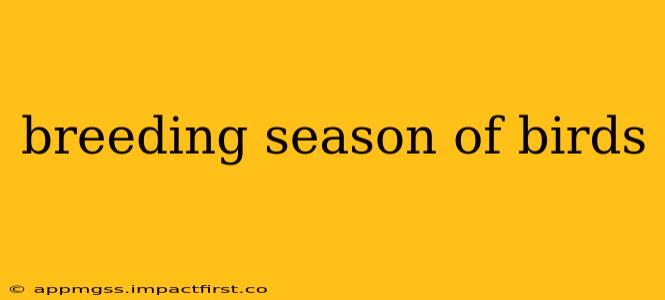The breeding season of birds, a vibrant period of courtship, nest building, egg laying, and chick rearing, is a fascinating aspect of avian biology. This crucial time in a bird's life cycle is influenced by a complex interplay of factors, ensuring the survival and continuation of their species. Understanding these factors provides insight into the intricate workings of the natural world.
What triggers the breeding season in birds?
The primary trigger for the breeding season in birds is photoperiod, or the length of daylight hours. As days lengthen in spring, hormonal changes are initiated, leading to increased reproductive activity. This isn't a universal switch, however; variations exist based on species and geographical location. Other contributing factors include:
- Temperature: Warmer temperatures are essential for successful breeding, providing optimal conditions for incubation and chick development.
- Food Availability: Abundant food resources are critical for providing energy for breeding activities and nourishing the growing chicks. A shortage of food can delay or even prevent breeding.
- Rainfall: Sufficient rainfall is crucial in many regions, ensuring the availability of water and promoting the growth of vegetation which supports insect populations – a key food source for many bird species.
- Migration: For migratory birds, arrival at their breeding grounds is a critical factor in initiating the breeding season.
When does the breeding season typically occur?
The breeding season varies greatly depending on the bird species and its geographic location. Generally, it occurs during the spring and summer months in temperate regions, coinciding with the increase in daylight hours and favorable environmental conditions. Tropical birds, however, may breed year-round or exhibit a more flexible breeding season influenced by rainfall patterns or food availability.
How long does the breeding season last?
The duration of the breeding season is species-specific. Some birds may have a relatively short breeding season lasting only a few weeks, while others may breed for several months. The length depends on factors like incubation period, chick development time, and the availability of resources.
What are the stages of the breeding season?
The breeding season typically involves several distinct stages:
- Territory establishment: Birds often establish and defend territories to secure resources for breeding and raising young.
- Courtship: Elaborate courtship displays, involving songs, dances, and plumage displays, attract mates and strengthen pair bonds.
- Nest building: Birds construct nests using various materials, providing a safe and sheltered environment for eggs and chicks.
- Egg laying and incubation: Females lay eggs, which are then incubated by one or both parents, maintaining the necessary temperature for embryonic development.
- Chick rearing: After hatching, parents provide food and protection for the chicks until they are able to fend for themselves.
How do different bird species differ in their breeding behaviors?
Bird breeding behaviors are incredibly diverse, reflecting the wide range of adaptations found in avian species. Consider these examples:
- Monogamy vs. Polygamy: Some birds form strong pair bonds (monogamy) for a breeding season or even a lifetime, while others mate with multiple partners (polygamy).
- Nest Construction: Nest designs vary tremendously, from simple scrapes on the ground to elaborate woven structures.
- Parental Care: Levels of parental care vary widely, with some species providing extensive care to their young, while others offer minimal parental investment.
What are some challenges birds face during the breeding season?
Breeding birds face numerous challenges, including:
- Predation: Nests and chicks are vulnerable to predators, such as snakes, rodents, and other birds.
- Disease: Disease can decimate a clutch or even an entire population.
- Habitat loss: Destruction of natural habitats leaves birds without suitable breeding grounds.
- Climate change: Shifting weather patterns can disrupt the timing of the breeding season and impact food availability.
Understanding the complexities of the avian breeding season highlights the intricate balance within ecosystems and the importance of conservation efforts to protect these vital processes. By continuing to study these fascinating creatures, we can better appreciate their role in the environment and work towards ensuring their survival.
